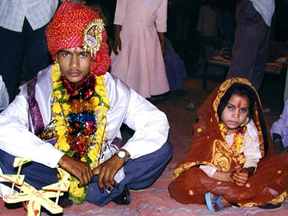 UNITED NATIONS: India had the highest number of unregistered children under age five between 2000 and 2012 and the second-highest number of child marriages, according to a UN report which said the country still needs to improve immunization coverage and stop gender-based sex selection.
UNITED NATIONS: India had the highest number of unregistered children under age five between 2000 and 2012 and the second-highest number of child marriages, according to a UN report which said the country still needs to improve immunization coverage and stop gender-based sex selection.
The report ‘Improving Children’s Lives, Transforming the Future – 25 years of child rights in South Asia’ by the United Nations’ children agency UNICEF analyzes the progress made over the last quarter century on key issues that directly affect the lives of children in the region.
At 71 million, India had the largest number of children under the age of five whose births were not registered between 2000-2012.
The report said that birth registration levels in South Asia have increased since 2000, but progress has been slow.
India, along with Afghanistan, Bangladesh and the Maldives, has been recording “significant improvements” in birth registration but about 100 million children in the region are still not registered at birth.
India has the greatest disparity between the poorest and richest households, with children in the poorest households being three times less likely to be registered than those in the richest.
Religion also appears to play a role as Muslims have the lowest level of birth registration in India (39 per cent) followed by Hindus (40 per cent) while the Jains have the highest (87 per cent).
The highest rate of child marriage is in Bangladesh (where two out of every three girls marry before age 18), followed by India, Nepal and Afghanistan.
Almost half of all girls in South Asia marry before the age of 18. One in five girls are married before the age of 15.
These are the highest rates in the world.
“These figures confirm that child marriage is rooted in gender norms and in expectations about the value and roles of girls,” the report added.
In India, 43 per cent of women aged 20-24 were first married by the age of 18 between 2005-2013. Girls with no education are 5.5 times more likely to marry or enter into union as those with at least 10 years of education.
On gender-biased sex selection, the report said the practice is more prevalent in the west and northwest part of the country. The child sex ratio, which is the number of girls per 1,000 boys, among children aged 0-4 in India was 924.
On immunization coverage, it said some countries in South Asia, particularly Bangladesh, Sri Lanka and Nepal, have made significant improvements since 1990 but coverage is still far too low in Afghanistan, India and Pakistan. The report said that despite the existence of legislation that prohibits expectant parents from having tests conducted to determine the gender of unborn children, the “situation is getting worse in India.”
India had close to seven million fewer girls than boys aged 0-6 in 2011.
Further, the sex ratio at birth is higher in wealthier households in India while the poorer households have higher fertility rates and less access to modern technology that is able to detect the baby’s sex.
Key findings of the report include that approximately 8 million children below the age of one are not immunized, more than 45 per cent of girls marry before the age of 18, South Asia is home to the largest number of stunted children in the world, nearly 700 million people still defecate in the open and nearly 100 million children under five are not registered at birth.
India had 6,860,000 unimmunized children under one year of age in 2012, the report said.
“South Asia continues to be one of the riskiest places in the world to become pregnant or give birth, with the second highest number of maternal deaths worldwide,” Regional Director for UNICEF in South Asia Karin Hulshof said.
“Far too many children get married, and far too many girls are never born. But together, we can turn the tide.”
The report also noted that 27 million children aged 5-13 are out of school in Bangladesh, India, Pakistan and Sri Lanka.
In Pakistan, one in three children (or 33 per cent) aged 5-9 are not in school while in India the rate of exclusion from primary education is six per cent.
India also accounts for about 90 per cent of the open defecators in the region.
States with the most rural open defecators are Uttar Pradesh (129 million), Bihar (80 million), Maharashtra (53 million), Madhya Pradesh (52 million), Rajasthan (45 million), West Bengal (38 million) and Odisha (33 million).
Open defecation also puts the health and safety of women and girls at risk.
While the proportion of people practicing open defecation is declining, the region is not on track to meet the Millennium Development Goals target for sanitation.
The report also noted that over 60 million children under the age of five in India, 48 percent of this age group, have stunted growth with poor sanitation being a major underlying cause for children being too short for their age.–PTI





